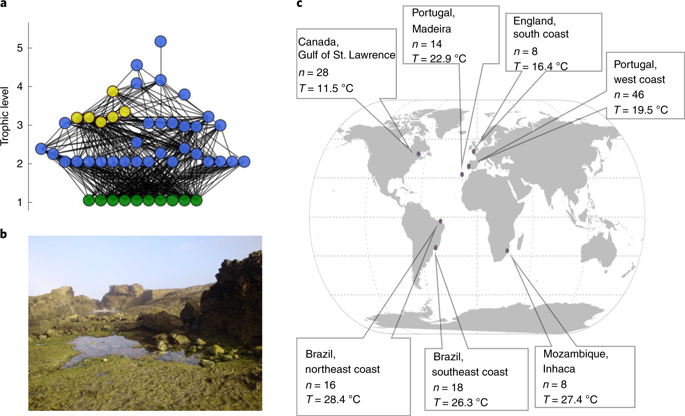Nature Climate Change ( IF 30.7 ) Pub Date : 2020-02-17 , DOI: 10.1038/s41558-020-0698-z Benoit Gauzens , Björn C. Rall , Vanessa Mendonça , Catarina Vinagre , Ulrich Brose

|
Global warming threatens community stability and biodiversity around the globe. Knowledge of the mechanisms underlying the responses to rising temperatures depends heavily on generic food-web models that do not account for changes in network structure along latitudes and temperature gradients. Using 124 marine rock-pool food webs sampled across four continents, we show that despite substantial variation in ambient temperature (mean 11.5–28.4 °C), similar empirical food-web and body-mass structures emerge. We have used dynamic modelling to test whether communities from warmer regions are more sensitive to warming and found a general hump-shaped relationship between simulated biodiversity and temperature (gradient from 0–50 °C). This implies that an expected anthropogenic global warming of 4 °C should increase biodiversity in arctic to temperate regions while biodiversity in tropical regions should decrease. Interestingly, simulations of synthetic networks did not yield similar results, which stresses the importance of considering the specificities of natural food webs for predicting community responses to environmental changes.
中文翻译:

响应跨纬度变暖的潮间带食物网的生物多样性
全球变暖威胁着全球社区的稳定和生物多样性。对温度升高响应机制的了解在很大程度上取决于通用食物网模型,该模型不考虑网络结构沿纬度和温度梯度的变化。我们使用在四大洲采样的 124 个海洋岩石池食物网,表明尽管环境温度有很大变化(平均 11.5-28.4°C),但出现了类似的经验食物网和体重结构。我们使用动态模型来测试来自温暖地区的社区是否对变暖更敏感,并发现模拟的生物多样性和温度之间存在一般的驼峰形关系(梯度从 0 到 50°C)。这意味着 4 °C 的预期人为全球变暖应该会增加北极至温带地区的生物多样性,而热带地区的生物多样性应该会减少。有趣的是,合成网络的模拟没有产生类似的结果,这强调了考虑天然食物网的特殊性对于预测社区对环境变化的反应的重要性。


























 京公网安备 11010802027423号
京公网安备 11010802027423号